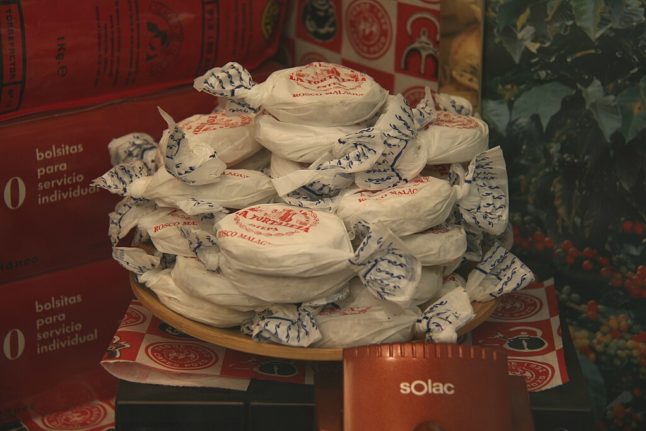Polvorones are soft and extremely crumbly shortbread-type cookies that take their name from the Spanish word polvo, meaning powder. This is because they are so crumbly and dry in fact that they can very easily turn into powder and almost seem to do so in the mouth.
They are made from mixing flour, animal fat, sugar, cinnamon and almonds, like many Christmas Spanish treats such as turrón (similar to nougat) and marzipan.
The Spanish Royal Academy says that the polvoron is a “sweet made with lard, ground almonds, flour and sugar, which is flavoured with cinnamon or lemon zest and baked in the oven”. Also that “it is characterised by its grainy texture and by falling apart when bitten”.
It’s not so unusual in fact that they’re made from animal fat as lots of Spanish sweets and pastries are, including Mallorcan ensaimadas, mantecados (similar to polvorones), and fartónes (sweet bread rolls from Valencia typically eaten with horchata).
Although you can find polvorones all over Spain, they originated in Andalusia and the majority are still made in the region today. They are traditionally from the municipality of Estepa in the province of Seville, in Sanlúcar de Barrameda in the province of Cádiz and in Almería.
READ ALSO: Ten traditional delights that make a real Spanish Christmas feast
They are also made in Tordesillas in Valladolid and Tafalla in Navarra.
These sweet dry shortbread cookies date back to the 16th century, when at the time there was a surplus of cereals and pig fat in Andalusia.
Later, in the 19th century, a woman named Filomena Micaela Ruiz Téllez from Estepa started making and selling mantecados. Before she sold them, however, she dried them so that they would be preserved much better, making them more crumbly too, and essentially making polvorones instead.
In the 20th century, the product gained in popularity and brands started making them instead of just home bakers and bakeries. Some of the most popular brands today are La Estepeña, El Toro, Puerta del Ángel and Dulces Gamito.
READ ALSO: Christmas travel between Spain and the UK: What can I not pack in my suitcase?
Although polvorones are very similar to mantecados and are both eaten at Christmas, they differ from one another slightly. Polvorónes are actually a type of mantecado. The main difference is that polvorones contain almonds, are drier and have a slightly different shape.
The main reason they became associated with Christmas, however, is that animals are typically taken to slaughter in November or early December. The lard or manteca is left over when processing the meat, which starts to go rancid as the months go by. Therefore, people decided to use it up before the end of the year, in order to make festive treats.
The use of lard in Spanish cooking stretches back hundreds of years and is still a popular ingredient here.



 Please whitelist us to continue reading.
Please whitelist us to continue reading.
Member comments